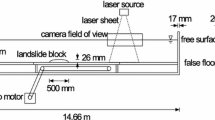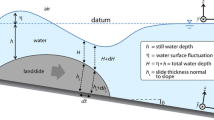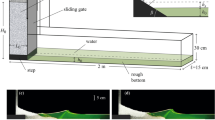Abstract
The waves generated by a submarine landslide, of great concern to coastal communities, exhibit strong dependence on the landslide motion along the sea floor. A series of two-dimensional physical experiments investigate the waves generated by a solid block landslide moving along a horizontal boundary, allowing measurement of both onshore- and offshore-propagating waves using the laser-induced fluorescence technique. This technique provides high-quality free surface measurements over the entire length of the experimental flume, and hence a data set that can be used to validate numerical models for this idealised scenario. The landslide motion is provided by a mechanical system, allowing testing of a range of landslide accelerations and terminal velocities. The landslide Froude number governs the overall behaviour of the wave field. At lower Froude numbers, the waves are almost entirely generated by the landslide acceleration and deceleration, and the offshore- and onshore-propagating wave groups contain approximately equal energy. Interactions between the landslide and the offshore-propagating waves become more important as the Froude number increases. Two inviscid-irrotational models demonstrate the importance of dispersive effects for tsunamis generated by a submarine landslide, and correctly predict the behaviour of the entire wave field at low Froude numbers. The predictions in the vicinity of the landslide worsen with increasing Froude number, due to the linear free surface conditions used by the models. Lower Froude numbers appear to be more representative of previous sloping-boundary experimental geometries, although rigid block landslides still represent an idealisation of a field scenario.














Similar content being viewed by others
References
Di Risio M, De Girolamo P, Bellotti G, Panizzo A, Aristodemo F, Molfetta MG, Petrillo AF (2009) Landslide-generated tsunamis runup at the coast of a conical island: New physical model experiments. J Geophys Res 114(C1), C01,009
Enet F, Grilli ST (2007) Experimental study of tsunami generation by three-dimensional rigid underwater landslides. J Waterw Port Coast Ocean Eng 133(6):442–454
Fritz HM, Hager WH, Minor HE (2003) Landslide generated impulse waves. Exp Fluids 35(6):505–519
Fritz HM, Hager WH, Minor HE (2003) Landslide generated impulse waves. 2. Hydrodynamic impact craters. Exp Fluids 35(6):520–532
Fritz HM, Hager WH, Minor HE (2004) Near field characteristics of landslide generated impulse waves. J Waterw Port Coast Ocean Eng 130(6):287–302
Fritz HM, Mohammed F, Yoo J (2009) Lituya Bay landslide impact generated mega-tsunami 50th anniversary. Pure Appl Geophys 166(1–2):153–153-175
Grilli ST, Bengston A, Watts P, Imamura F (2001) Benchmark cases for tsunamis generated by underwater landslides. Ocean Wave Meas Anal 2001:1505–1514
Grilli ST, Vogelmann S, Watts P (2002) Development of a 3D numerical wave tank for modeling tsunami generation by underwater landslides. Eng Anal Bound Elem 26(4):301–313
Grilli ST, Watts P (1999) Modeling of waves generated by a moving submerged body. Applications to underwater landslides. Eng Anal Bound Elem 23(8):645–656
Grilli ST, Watts P (2005) Tsunami generation by submarine mass failure. I: modeling, experimental validation, and sensitivity analyses. J Waterw Port Coast Ocean Eng 131(6):283–297
Hampton MA, Lee HJ, Locat J (1996) Submarine landslides. Rev Geophys 34(1):33–59. doi:http://dx.doi.org/10.1029/95RG03287
Heinrich P (1992) Nonlinear water waves generated by submarine and aerial landslides. J Waterw Port Coast Ocean Eng 118(3):249–266
Heller V, Hager WH, Minor HE (2008) Scale effects in subaerial landslide generated impulse waves. Exp Fluids 44(5):691–703 doi:http://dx.doi.org/10.1007/s00348-007-0427-7
Imamura F, Hashi K (2003) Re-examination of the source mechanism of the 1998 Papua New Guinea earthquake and tsunami. Pure Appl Geophys 160(10):2071–2086
Jiang L, LeBlond PH (1992) The coupling of a submarine slide and the surface waves which it generates. J Geophys Res 97(C8):12731–12744
Jiang L, LeBlond PH (1993) Numerical modeling of an underwater Bingham plastic mudslide and the waves which it generates. J Geophys Res 98(C6):10303–10317
Jiang L, Leblond PH (1994) Three-dimensional modeling of tsunami generation due to a submarine mudslide. J Phys Oceanogr 24(3):559–572
Kaijura K (1963) The leading wave of a tsunami. Bull Earthq Res Instit 41(33):535–571
Lee SJ, Yates GT, Wu TY (1989) Experiments and analyses of upstream-advancing solitary waves generated by moving disturbances. J Fluid Mech 199:569–593
Lighthill J (1978) Waves in fluids. Cambridge University Press, Cambridge
Locat J, Lee HJ (2002) Submarine landslides: advances and challenges. Can Geotech J 39(1):193–212
Lynett PJ, Borrero JC, Liu PLF, Synolakis CE (2003) Field survey and numerical simulations: a review of the 1998 Papua New Guinea tsunami. Pure Appl Geophys 160(10):2119–2146
Matsumoto T, Tappin DR (2003) Possible coseismic large-scale landslide off the northern coast of Papua New Guinea in July 1998: geophysical and geological results from SOS cruises. Pure Appl Geophys 160(10):1923–1943
Mei CC, Stiassnie M, Yue DKP (2005) Theory and applications of ocean surface waves: linear aspects, vol. 23. World Scientific
Nokes R (2014) Streams 2.02: system theory and design. University of Canterbury
Pelinovsky E, Poplavsky A (1996) Simplified model of tsunami generation by submarine landslides. Phys Chem Earth 21(12), 13–17 doi:http://dx.doi.org/10.1016/S0079-1946(97)00003-7. Tsunamis Impacting on the European Coasts: Modelling, Observation and Warning
Qiu LC (2008) Two-dimensional SPH simulations of landslide-generated water waves. J Hydraul Eng 134(5):668–671
Renzi E, Sammarco P (2010) Landslide tsunamis propagating around a conical island. J Fluid Mech 650(1):251–285
Rzadkiewicz SA, Mariotti C, Heinrich P (1997) Numerical simulation of submarine landslides and their hydraulic effects. J Waterw Port Coast Ocean Eng 123(4):149–157
Sammarco P, Renzi E (2008) Landslide tsunamis propagating along a plane beach. J Fluid Mech 598(1):107–119
Satake K, Tanioka Y (2003) The July 1998 Papua New Guinea earthquake; mechanism and quantification of unusual tsunami generation. Pure Appl Geophys 160(10—-11):2087–2118
Sue L, Nokes R, Davidson M (2011) Tsunami generation by submarine landslides: comparison of physical and numerical models. Environ Fluid Mech 11(2):133–165
Sue LP (2007) Modelling of tsunami generated by submarine landslides. Ph.D. thesis, University of Canterbury
Synolakis CE, Bardet JP, Borrero JC, Davies HL, Okal EA, Silver EA, Sweet S, Tappin DR (2002) The slump origin of the 1998 Papua New Guinea tsunami. Proc Math Phys Eng Sci 458(2020):763–789
Watts P (2000) Tsunami features of solid block underwater landslides. J Waterw Port Coast Ocean Eng 126(3):144–152
Weiss R, Fritz HM, Wannemann K (2009) Hybrid modeling of the mega-tsunami runup in Lituya Bay after half a century. Geophys Res Lett 36(9), L09,602
Whittaker CN (2013) Modelling of tsunami generated by the motion of a rigid block along a horizontal boundary. Ph.D. thesis, University of Canterbury
Acknowledgments
The laboratory work in this project was conducted with the assistance of Ian Sheppard, Kevin Wines, Alan Stokes and Mike Weavers. The contributions of Sarah Delavan and Pedro Lee, as well as the comments of the two anonymous reviewers, are also appreciated.
Author information
Authors and Affiliations
Corresponding author
Rights and permissions
About this article
Cite this article
Whittaker, C., Nokes, R. & Davidson, M. Tsunami forcing by a low Froude number landslide. Environ Fluid Mech 15, 1215–1239 (2015). https://doi.org/10.1007/s10652-015-9411-6
Received:
Accepted:
Published:
Issue Date:
DOI: https://doi.org/10.1007/s10652-015-9411-6




